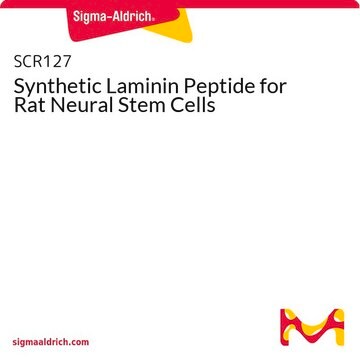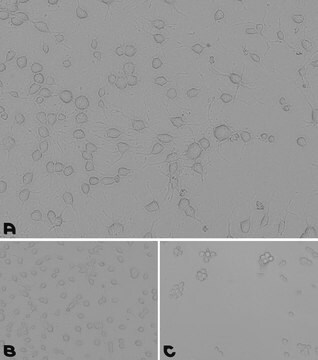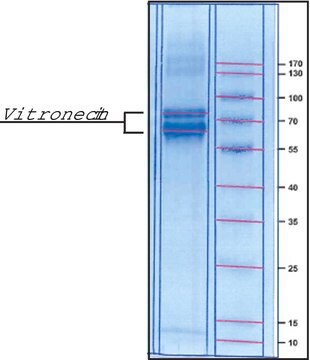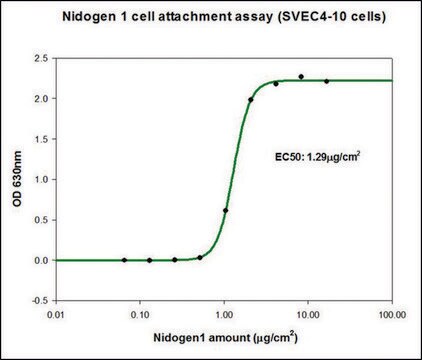L6274
Laminin from human placenta
liquid, BioReagent, suitable for cell culture
Sinónimos:
Cell culture grade laminin, Human Laminin
Iniciar sesiónpara Ver la Fijación de precios por contrato y de la organización
About This Item
Productos recomendados
origen biológico
human placenta
Nivel de calidad
Línea del producto
BioReagent
Formulario
liquid
concentración
0.5 mg/mL in Tris-buffered saline
técnicas
cell culture | mammalian: suitable
cobertura de la superficie
1‑2 μg/cm2
Nº de acceso UniProt
Condiciones de envío
dry ice
temp. de almacenamiento
−70°C
Información sobre el gen
human ... LAMB1(3912)
Aplicación
Laminin supports growth and differentiation of many cell types including epithelial, endothelial, neural, muscle and liver cells. It is recommended for use as a cell culture substratum at 1-2 μg/cm2. The optimal concentration does depend on cell type as well as the application or research objectives.
Acciones bioquímicas o fisiológicas
Laminin proteins are integral components of structural scaffolding in animal tissues. They associate with type IV collagen via entactin and perlecan and bind to cell membranes through integrin receptors, dystroglycan glycoprotein complexes and Lutheran blood group glycoproteins. Laminin has active domains for collagen binding, cell adhesion, heparin binding, and neurite outgrowth fragment.
Componentes
Laminin is an extracellular matrix multidomain trimeric glycoprotein, and is the main non-collagenous component of basal lamina that supports adhesion, proliferation and differentiation. Laminin is composed of both A, B1 and B2 chains, which are connected by many disulfide bonds. This laminin product is purified from human placenta using pepsin treatment and immunoaffinity chromatography. SDS-PAGE results in two major bands at 50 kDa and 130-160 kDa.
Precaución
It is recommended to store this product at -70°C, where it will remain stable for two years.
Nota de preparación
This product is supplied at a concentration of 0.5 mg/mL in 50 mM Tris-HCl, with 150 mM NaCl. It is 0.2 μm filtered. Thaw this solution slowly before use at 2-8°C to avoid gel formation. For use as a coating, dilute in a sterile balanced salt solution, coat culture surface with a minimal volume and incubate at 37°C for two hours. Wash 3 times with PBS before plating cells. Laminin coatings can be stored for one month at 2-8°C.
Código de clase de almacenamiento
10 - Combustible liquids
Clase de riesgo para el agua (WGK)
WGK 3
Punto de inflamabilidad (°F)
Not applicable
Punto de inflamabilidad (°C)
Not applicable
Elija entre una de las versiones más recientes:
¿Ya tiene este producto?
Encuentre la documentación para los productos que ha comprado recientemente en la Biblioteca de documentos.
Los clientes también vieron
Satu Marja Myllymäki et al.
PloS one, 6(5), e19453-e19453 (2011-05-17)
Formation of apical compartments underlies the morphogenesis of most epithelial organs during development. The extracellular matrix (ECM), particularly the basement membrane (BM), plays an important role in orienting the apico-basal polarity and thereby the positioning of apical lumens. Integrins have
Sandhanakrishnan Cattavarayane et al.
BMC cell biology, 16, 3-3 (2015-04-19)
The growth properties and self-renewal capacity of embryonic stem (ES) cells are regulated by their immediate microenvironment such as the extracellular matrix (ECM). Integrins, a central family of cellular ECM receptors, have been implicated in these processes but their specific
Danielle K Lewis et al.
Aging cell, 7(6), 836-849 (2008-09-10)
Astrocytes comprise a large proportion of the central nervous system support cells and play a critical role in neural injury and repair. The present study examined the impact of ovarian aging using an ex vivo model system, where astrocytes were
Terhi P Teräväinen et al.
PloS one, 8(8), e71485-e71485 (2013-08-27)
The properties of epithelial cells within tissues are regulated by their immediate microenvironment, which consists of neighboring cells and the extracellular matrix (ECM). Integrin heterodimers orchestrate dynamic assembly and disassembly of cell-ECM connections and thereby convey biochemical and mechanical information
Pere Roca-Cusachs et al.
Proceedings of the National Academy of Sciences of the United States of America, 106(38), 16245-16250 (2009-10-07)
A key molecular link between cells and the extracellular matrix is the binding between fibronectin and integrins alpha(5)beta(1) and alpha(v)beta(3). However, the roles of these different integrins in establishing adhesion remain unclear. We tested the adhesion strength of fibronectin-integrin-cytoskeleton linkages
Artículos
Cancer stem cell media, spheroid plates and cancer stem cell markers to culture and characterize CSC populations.
Nuestro equipo de científicos tiene experiencia en todas las áreas de investigación: Ciencias de la vida, Ciencia de los materiales, Síntesis química, Cromatografía, Analítica y muchas otras.
Póngase en contacto con el Servicio técnico













